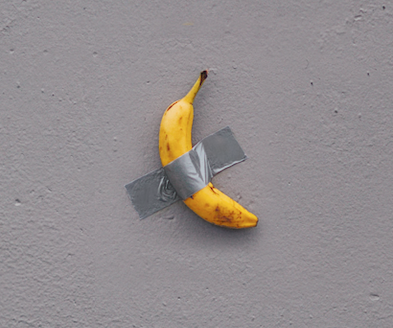Hot take: modern art sucks
The movement of this kind of art is part of a greater problem that permeates society: hard work and skill are not as valued as they once were.

A recreation of Maurizio Cattelan’s “Comedian.”
Oct 11, 2021
Many are familiar with the infamous banana duct taped to a wall in an art gallery. This piece is titled “Comedian” and was created by Maurizio Cattelan, who is also known for his sculpture of a golden toilet. Shortly after it sold for $120,000, performance artist David Datuna recorded a video of himself ripping the banana off of the wall and eating it. I like to interpret Datuna’s actions as protesting against the current standards of art. Too often do we see artwork that a child could easily replicate being sold for the same price as a house. The phrase “anything is art” is a true statement, but some folks take it to a whole new extreme. A banana duct-taped to a wall is considered art in a technical sense, but I tend to question whether this piece and others like it should really be lauded as ground-breaking or extraordinary.
I invite you to google Mark Rothko’s art. Rothko was known for his colorful rectangles. His application of color theory could certainly be commended, but what else is there? How long did it take Mr. Rothko to make these? How easy would it be for an amateur artist to replicate his work? What makes his work so profound? I say that there is nothing remarkable about Rothko’s work. It’s literally just colorful squares and rectangles. That’s it. It doesn’t take genius to see that blue means sad, red means angry, and so on and so forth. Without the title of the painting or the supposed motive for its creation (sadness, anger, etc.) the art has no real value. It rings very similar to those “I’m fourteen and this is deep” posts that trick the viewer into believing that they’re such intuitive and deep thinkers by being able to interpret simple metaphors and analogies that tend to be very much on the nose.
Let me be clear: I do not have a problem with bananas duct-taped to walls as a concept. It’s actually quite humorous. What I do have a problem with is selling it for more money than some families make in a year. The movement of this kind of art is part of a greater problem that permeates society: hard work and skill are not as valued as they once were. This is most evident in the art world, as wealthy folks with connections utilize their assets to make a quick buck off a few scribbles on a board. It isn’t fair to those who spend years studying how the light hits a certain object and where muscles lie in the human body. Those that demonstrate immense skill deserve to have their work being sold for as much as a banana duct-taped to a wall.
I find Mr. Cattelan’s actions, not the work itself, insulting. Cattelan is known for creating hyper-realistic sculptures, yet he opted to use a real banana for this project. He also instructed the gallery where this piece was displayed to replace the banana as necessary. In my opinion, this makes his actions even more egregious. With “Comedian,” Cattelan makes a mockery of artists. It’s one thing if this piece was created by a child, but it’s an entirely different case when a critically acclaimed artist puts a lofty value on a piece of work that would otherwise be meaningless. Cattelan probably intended for his art to be taken as a joke. It is titled “Comedian” after all. Cattelan is commonly referred to as the “jokester of the art world,” but jokes are not infallible. Thousands of “starving artists” who have traded their souls just for a thin slice of success suffer at the expense of this little “prank.” Both of these materials combined probably cost under ten dollars and yet the entire piece is sold for $120,000 because it was attached to a name. How and why do we let this happen? In my mind, there is no other excuse for this than laziness, and nothing Cattelan can say will ever change my mind.












callum wales • Apr 17, 2025 at 5:58 am
dude this isn’t a “hot take” its just logic
Curious • Apr 10, 2025 at 1:00 pm
I could assert my opinion, but I’d rather keep an open mind and ask a question. For those who say they love the banana on the wall, I want to know why. Why do you love the banana on the wall? I’m looking for something more than “it’s modern art.”
Uniesme206@gmail.com • Mar 21, 2025 at 9:29 am
I really loved this because it is considering modern art which i would buy it for 7.9million dollars
sigma rizzler • Mar 21, 2025 at 9:26 am
I really think this is art because it really shows that it is modern art it was very beautiful and it touched my heart.
sigma rizzler • Feb 4, 2025 at 1:00 pm
i truly loved this art and it inspired me to draw and become an artist.
talbjcu • Oct 11, 2021 at 3:04 pm The Carroll News Pick
I can’t help but agree. It may technically be art but it holds no artistic value; it is really just a waste of food & a mockery of all those who toil for years to make grand works of art yet never receive any pay or recognition for it. I was actually just talking about this the other day after visiting the art museum!
THE ALPHA LEADER • Feb 4, 2025 at 12:51 pm
i agree but i really like the duct taped banana, it really touched my heart and inspired me.
Buts • Mar 21, 2025 at 9:29 pm
I really loved it so stop saying it sucks